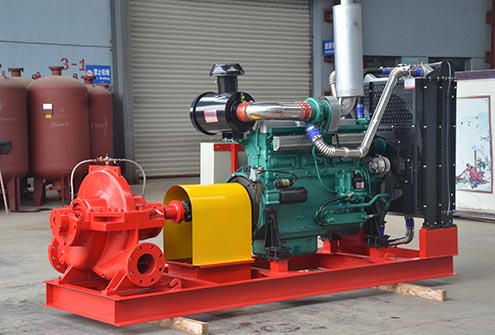The maintenance of diesel fire pump
The maintenance of the diesel fire pump should strictly implement the maintenance system, so that the diesel fire pump always maintains a good technical state and a clean appearance, and is always ready to adapt to a fast and effective response. In an emergency, and put out the fire in a timely manner.
The diesel engine fire pump should be maintained every day.
Daily maintenance
1. Keep the engine room tidy. The diesel engine fire pump and its supporting equipment should be flexible and reliable.
2. Check whether the connections of the diesel engine fire pump are good, whether the rotating parts are flexible, whether the oil circuits, and meters are connected reliably, whether the wiring is loose, and whether the foam mixing system and cooling system are complete and normal;
3. Check whether the capacity of fuel tank, oil pan, heat exchanger, water guide tank and foam liquid is sufficient, and add it in time if insufficient;
4. Check whether the engine oil circuit is normal and reliable to ensure that it can be put into operation at any time;
5. The engine must be started daily to check its starting performance. Pumping must be done several times a week after idling.
First-class maintenance
Every three months or accumulated 100 hours of operation, level 1 maintenance must be performed with lubrication and tightening as the center.
1. Clean the exterior of each component of the unit;
2. Check the oil level of the engine crankcase, check whether the crankcase ventilation pipe is good, and whether the device is firm;
3. Check the amount of oil in the pump grease cup and add it if necessary;
4. Check and adjust the tightness of the belt.
5. Check the surface of engine oil, water pump, and clean air plug;
6. Check the tightness of the engine, water pump, transmission and piping;
7. Clean the outside of the battery, add distilled water and sufficient power;
8. Clean the air filter;
9. Lubricate each lubrication point as needed.
Two-class maintenance
After running every 6 months or 500 hours, secondary maintenance must be carried out based on inspection and adjustment. The items are as follows:
1. First level maintenance of all items;
2. Clean the oil filter and replace the filter element;
3. Check the engine lubrication system and replace with new oil;
4.Clean fuel tank, oil pump filter and pipeline;
5. Replace paper fuel filter;
6. Clean oil pan and oil pumping unit;
7. Check and adjust valve clearance and injection pump advance angle;
8. Disassemble and check the injection pump and fuel pump as required, check the injection pressure and injection condition of the high-speed injector;
9. Check the battery level and electrolyte concentration, remove the air holes on the battery cover, and charge if necessary;
10. Inspect electrical equipment, clean and lubricate starter and engine bearings
11. Check the tightness of the pump. The inlet and outlet of the pump are closed, and the vacuum pump is used to test the vacuum. When the vacuum dialing reading reaches 0.79mpa, the vacuum drop should not be greater than 0.03mpa / min during the shutdown test. If the vacuum drips too fast, check and eliminate the cause of the leak in time;
12. Lubricate each lubrication point as required.
Three-class maintenance
The pump set generally runs for 1000-1500 hours, or it is found that the engine power is significantly reduced, the diesel consumption is increased, the exhaust smoke or blue smoke is decomposed as a whole, and the three-level maintenance should be carried out:
1. All major maintenance and secondary maintenance items.
2. Disassemble and inspect engine assembly:
1) Clean up the carbon deposits in the combustion chamber, exhaust pipe and muffler;
2) Measure the amount of wear in the cylinder and change the piston ring and cylinder liner if necessary;
3) Check the clearance between the connecting rod bearing and the crankshaft main bearing, replace the bearing if necessary, check the axial clearance of the camshaft and crankshaft, and adjust if necessary;
4) Check the tightness of the valve seat and grind if necessary.
5) Clean the cylinder block, oil pan and oil strainer;
6) Clean the dirt on the heat exchanger and engine water tank, and check the function of the thermostat.
7) Remove the pump, clean and change the oil; remove the foam agitator and remove the dirt;
8) Perform a pressure test of 1.5 times the rated outlet pressure of the pipeline output system, and replace leaking pipes and valves timely;
9) If necessary, paint again;
10) Lubricate each lubrication point as required.

